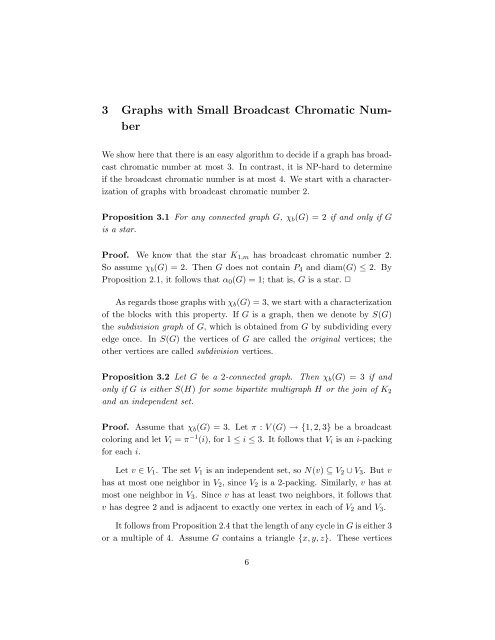Broadcast Chromatic Numbers of Graphs 1 ... - ResearchGate
Broadcast Chromatic Numbers of Graphs 1 ... - ResearchGate
Broadcast Chromatic Numbers of Graphs 1 ... - ResearchGate
You also want an ePaper? Increase the reach of your titles
YUMPU automatically turns print PDFs into web optimized ePapers that Google loves.
3 <strong>Graphs</strong> with Small <strong>Broadcast</strong> <strong>Chromatic</strong> NumberWe show here that there is an easy algorithm to decide if a graph has broadcastchromatic number at most 3. In contrast, it is NP-hard to determineif the broadcast chromatic number is at most 4. We start with a characterization<strong>of</strong> graphs with broadcast chromatic number 2.Proposition 3.1 For any connected graph G, χ b (G) = 2 if and only if Gis a star.Pro<strong>of</strong>. We know that the star K 1,m has broadcast chromatic number 2.So assume χ b (G) = 2. Then G does not contain P 4 and diam(G) ≤ 2. ByProposition 2.1, it follows that α 0 (G) = 1; that is, G is a star. ✷As regards those graphs with χ b (G) = 3, we start with a characterization<strong>of</strong> the blocks with this property. If G is a graph, then we denote by S(G)the subdivision graph <strong>of</strong> G, which is obtained from G by subdividing everyedge once. In S(G) the vertices <strong>of</strong> G are called the original vertices; theother vertices are called subdivision vertices.Proposition 3.2 Let G be a 2-connected graph. Then χ b (G) = 3 if andonly if G is either S(H) for some bipartite multigraph H or the join <strong>of</strong> K 2and an independent set.Pro<strong>of</strong>. Assume that χ b (G) = 3. Let π : V (G) → {1, 2, 3} be a broadcastcoloring and let V i = π −1 (i), for 1 ≤ i ≤ 3. It follows that V i is an i-packingfor each i.Let v ∈ V 1 . The set V 1 is an independent set, so N(v) ⊆ V 2 ∪ V 3 . But vhas at most one neighbor in V 2 , since V 2 is a 2-packing. Similarly, v has atmost one neighbor in V 3 . Since v has at least two neighbors, it follows thatv has degree 2 and is adjacent to exactly one vertex in each <strong>of</strong> V 2 and V 3 .It follows from Proposition 2.4 that the length <strong>of</strong> any cycle in G is either 3or a multiple <strong>of</strong> 4. Assume G contains a triangle {x, y, z}. These vertices6
















